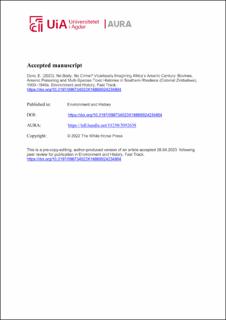| dc.contributor.author | Doro, Elijah | |
| dc.date.accessioned | 2023-09-28T09:28:36Z | |
| dc.date.available | 2023-09-28T09:28:36Z | |
| dc.date.created | 2023-06-22T23:04:12Z | |
| dc.date.issued | 2023 | |
| dc.identifier.citation | Doro, E. (2023). No Body, No Crime? Vicariously Imagining Africa’s Arsenic Century: Bovines, Arsenic Poisoning and Multi-Species Toxic Histories in Southern Rhodesia (Colonial Zimbabwe), 1900–1940s. Environment and History, Fast Track. | en_US |
| dc.identifier.issn | 1752-7023 | |
| dc.identifier.uri | https://hdl.handle.net/11250/3092638 | |
| dc.description | Author's accepted manuscript | en_US |
| dc.description | This is a pre-copy-editing, author-produced version of an article accepted 28.04.2023 following peer review for publication in Environment and History, Fast Track. https://doi.org/10.3197/096734023X16869924234804 | |
| dc.description.abstract | During the first half of the twentieth century, white settler farmers in colonial Zimbabwe raised incessant complaints and alarm over ‘mysterious’ and inexplicably frequent incidences of cattle mortalities. These mortalities were attributed to poisoning from careless handling of arsenical dips, ingestion of arsenic sprayed grass and grazing in veld impregnated with arsenic trioxide. The arsenic question occupied the attention of experts from the colonial Branch of Chemistry, toxicologists, bacteriologists, veterinary officials and white settler farmers in contested cattle-centred narratives. Within the framing of colonial toxic politics, cattle poisoning disproportionately received more elaborate scrutiny and attention than that of humans and other species. The colonial archive only affords limited and vague visibility to the toxic encounters of humans and non-bovine species. This paper seeks to transcend and interrogate bovine-centric poisoning discourses with which colonial sources are replete and to use existing cattle poisoning records to amplify and construct multi-species toxic histories connecting cattle, humans, landscapes and other species in a co-constituted narrative of arsenic toxicities. The paper employs vicarious imagination of experiences to reframe Africa’s ‘arsenic century’ and colonial toxic histories outside the body-centric script, and examines the intricate and complex chemical relations enmeshing cattle, humans and other species in ecosystems of mutual toxic vulnerabilities and slow chemical violence. The paper uses archival sources, toxicological reports from the Branch of Chemistry and veterinary records of cattle poisoning in colonial Zimbabwe. | en_US |
| dc.language.iso | eng | en_US |
| dc.publisher | White Horse Press | en_US |
| dc.title | No Body, No Crime? Vicariously Imagining Africa’s Arsenic Century: Bovines, Arsenic Poisoning and Multi-Species Toxic Histories in Southern Rhodesia (Colonial Zimbabwe), 1900–1940s | en_US |
| dc.type | Peer reviewed | en_US |
| dc.type | Journal article | en_US |
| dc.description.version | acceptedVersion | en_US |
| dc.rights.holder | © 2022 The White Horse Press | en_US |
| dc.source.pagenumber | 24 | en_US |
| dc.source.journal | Environment and History | en_US |
| dc.identifier.doi | https://doi.org/10.3197/096734023X16869924234804 | |
| dc.identifier.cristin | 2157288 | |
| cristin.qualitycode | 1 | |
